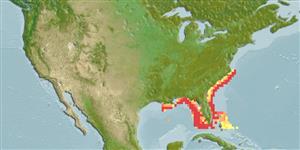Issue
Type locality: southern Florida and Pensacola, Florida.
Environment: milieu / climate zone / depth range / distribution range
Ökologie
seewasser demersal; tiefenbereich 25 - 183 m (Ref. 5222), usually 60 - 120 m (Ref. 5222). Subtropical; 36°N - 24°N, 98°W - 62°W (Ref. 5222)
Western Atlantic: Bermuda and the coast of the USA from North Carolina to the Florida Keys and in the northern and eastern Gulf of Mexico. Reports from Cuba and the Bahamas are unsubstantiated.
Size / Gewicht / Alter
Maturity: Lm ? range ? - ? cm
Max length : 110 cm TL Männchen/unbestimmt; (Ref. 5222); max. veröff. Gewicht: 30.0 kg (Ref. 5222); max. veröff. Alter: 45 Jahre (Ref. 93919)
Rückenflossenstacheln (insgesamt) : 11; Rückenflossenweichstrahlen (insgesamt) : 15 - 16; Afterflossenstacheln: 3; Afterflossenweichstrahlen: 9.
Inhabits offshore rocky bottoms; most common between 60 and 120 m.
Life cycle and mating behavior
Maturities | Fortpflanzung | Spawnings | Egg(s) | Fecundities | Larven
Heemstra, P.C. and J.E. Randall, 1993. FAO Species Catalogue. Vol. 16. Groupers of the world (family Serranidae, subfamily Epinephelinae). An annotated and illustrated catalogue of the grouper, rockcod, hind, coral grouper and lyretail species known to date. Rome: FAO. FAO Fish. Synop. 125(16):382 p. (Ref. 5222)
IUCN Rote Liste Status (Ref. 130435)
Bedrohung für Menschen
Harmless
Nutzung durch Menschen
Fischereien: kommerziell; Sportfisch: ja
Tools
Zusatzinformationen
Download XML
Internet Quellen
Estimates based on models
Preferred temperature (Ref.
123201): 17.7 - 25.2, mean 22.1 °C (based on 19 cells).
Phylogenetic diversity index (Ref.
82804): PD
50 = 0.5000 [Uniqueness, from 0.5 = low to 2.0 = high].
Bayesian length-weight: a=0.01122 (0.00653 - 0.01928), b=3.04 (2.90 - 3.18), in cm total length, based on LWR estimates for this species & Genus-body shape (Ref.
93245).
Trophic level (Ref.
69278): 4.0 ±0.6 se; based on size and trophs of closest relatives
Widerstandsfähigkeit (Ref.
120179): niedrig, Verdopplung der Population dauert 4,5 - 14 Jahre. (K=0.13; tmax=25).
Fishing Vulnerability (Ref.
59153): High vulnerability (62 of 100).
Nutrients (Ref.
124155): Calcium = 33.9 [14.0, 78.6] mg/100g; Iron = 0.783 [0.376, 1.829] mg/100g; Protein = 18.5 [16.8, 20.0] %; Omega3 = 0.292 [0.160, 0.530] g/100g; Selenium = 38.1 [17.9, 90.0] μg/100g; VitaminA = 19.9 [4.7, 83.9] μg/100g; Zinc = 0.705 [0.451, 1.142] mg/100g (wet weight);
